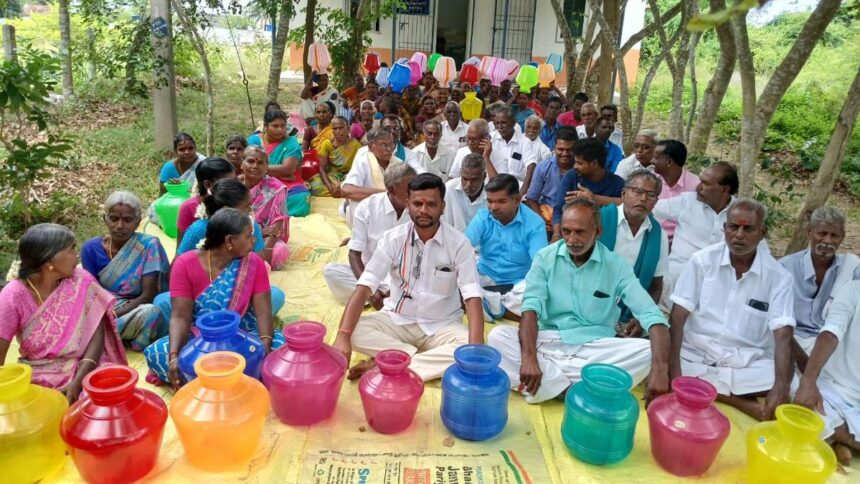
Twin Terminalia arjuna trees at the park that is integral to the MLAs hostel off Wallajah Salai, on August 5, 2025. Photos: Prince Frederick
| Photo Credit: PRINCE FREDERICK
What the reader sees in these pictures is affected by perspective distortion, the inevitable result of scrunching a three-dimensional reality into a flat, two-dimensional visual representation.
The two trees are not being represented as they truly are, their trunks far more massive in reality than they appear in those frames. When they have grown to maturity and exploited their full potential, Neermaruthu trees (Terminalia arjuna) stand tall and robust, exuding a presence comparable to celluloid superstars known to fill a screen. With its imposing stature, massive, smooth white trunk and the bough making for a dense canopy and the subsidiary branches simulating a skyward-bound cracker returning to terra firma in a shower of colour and light, a Neermaruthu is sure to force a passerby to take notice of it.
Twin Terminalia arjuna trees at the park that is integral to the MLAs hostel off Wallajah Salai, on August 5, 2025. Photos: Prince Frederick
| Photo Credit:
PRINCE FREDERICK
These two trees in the images achieve that effect, bringing out the paparazzi in most people. These Arjuna trees (as Neermaruthu trees are known outside Tamil Nadu) have the same door number as the MLAs Hostel in Chepauk, accessible via Sivananda Salai as well as Wallajah Salai. They are domiciled in a park at the Hostel. If one chose to reach it via the former road, they would understand this species’ essential character in a practical, unambiguous manner. In times when landscapes were left to themselves, Neermaruthu trees thrived along waterways and riverine systems, coastal and inland. They are identified with coastal wetlands.
Sivananda Salai is a jogging partner for the Cooum river in Chepauk; they run alongside each other. The Cooum as known to us now might be icky, but there is a recorded past when it did flow more swiftly with clearer waters.
“These twin Neermaruthu trees, as also one on the opposite side, at the MLAs Hostel premises occurred naturally, and were not planted. And they serve as an indicator species, decoding the arboreal past of the landscape,” says T.D. Babu, member of Chennai District Green Committee and a key member of tree conservation organisation Nizhal. “They presence along waterways is the result of the flowing waters dispersing the seeds. The seed is dispersed through water as the fruit is woody and float and get accumulated along the banks and starts germinating.”
Further illustrating the connection between Neermaruthu trees and riverine systems, he calls up the name of a town found on the banks of a Cauvery tributary in Thanjavur.
“Thiruvidaimarudur, a town in Thanjavur district is named after Neermaruthu as it is overrun with these trees,” says Babu, adding that this town’s location on the banks of Virasolanar, a tributary of Cauvery, contributes in no small measure to the species’ proliferation.
“Similarly, along the banks of Cauvery in Ogenakallu, one can only see huge-sized Neermaruthu trees.”
Back to the twin trees
Babu calls the two trees at the MLAs hostel twin trees. And, they sure come across as identical twins, if you ignore the fact that one has a lop-sided look, its branches on one side restrained by the presence of an artificial structure.
Babu says before this structure (which is in fact a wall made of metal sheet that is part of a badminton stadium) came up, this tree also had free-flowing branches, and together they twinned to the hilt.
A Terminalia arjuna tree at the park that is integral to the MLAs hostel off Wallajah Salai, on August 5, 2025. Photos: Prince Frederick
| Photo Credit:
PRINCE FREDERICK
Neemaruthu trees have as much utilitarian value as aesthetic value. Babu notes that the oval shaped leaves of the Neermaruthu is staple diet of the South Indian small tussore (Antheraea phapia), a moth providing tussar silk.
Looking at the twin trees at the MLA’s Hostel, one notices exfoliation, the barks that are peeling off seemingly inviting one to make us of them.
Says Babu, “Vagbatta emphasised the role of Neermaruth barks in preparation of Ayurvedic medicine for heart health.”
Published – August 07, 2025 11:22 am IST



















